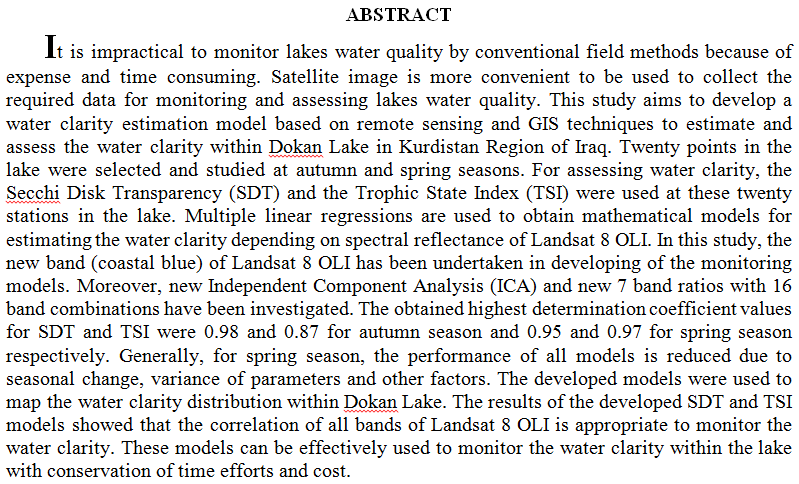
Electronic remote identification (ER-ID) is a new radio frequency (RF) technology that is initiated by the Federal Aviation Authorities (FAA). For security reasons, traffic control, and so on, ER-ID has been applied for drones by the FAA to enable them to transmit their unique identification and location so that unauthorized drones can be identified. The current limitation of the existing ER-ID algorithms is that the application is limited to the Wi-Fi and Bluetooth wireless controllers, which results in a maximum range of 10–20 m for Bluetooth and 50–100 m for Wi-Fi. In this study, a mathematical computing technique based on finite state automaton (FSA) is introduced to expand the range of the ER-ID RF system and reduce the ene
... Show More (5)
(5)
 (6)
(6)
 (2)
(2)
 (14)
(14)
 (15)
(15)
 (1)
(1)
 (2)
(2)
Individuals across different industries, including but not limited to agriculture, drones, pharmaceuticals and manufacturing, are increasingly using thermal cameras to achieve various safety and security goals. This widespread adoption is made possible by advancements in thermal imaging sensor technology. The current literature provides an in-depth exploration of thermography camera applications for detecting faults in sectors such as fire protection, manufacturing, aerospace, automotive, non-destructive testing and structural material industries. The current discussion builds on previous studies, emphasising the effectiveness of thermography cameras in distinguishing undetectable defects by the human eye. Various methods for defect
... Show More (1)
(1)
Pavement crack and pothole identification are important tasks in transportation maintenance and road safety. This study offers a novel technique for automatic asphalt pavement crack and pothole detection which is based on image processing. Different types of cracks (transverse, longitudinal, alligator-type, and potholes) can be identified with such techniques. The goal of this research is to evaluate road surface damage by extracting cracks and potholes, categorizing them from images and videos, and comparing the manual and the automated methods. The proposed method was tested on 50 images. The results obtained from image processing showed that the proposed method can detect cracks and potholes and identify their severity levels wit
... Show More (29)
(29)
 (23)
(23)
This study estimated seven heavy metals (Fe, Cu, Zn, Pb, Ni, Cd, Cr) in water (dissolved and particulate phase), sediments and some aquatic organisms including two species from aquatic plants (Ceratophyllum demersum&Phragmites australis); one species of clam (Psedontopeses euphratics) and two species from fish (Oreochromis aureus& Leuciscus vorax)in four sites within Mashroo AL- Musayyib channel project/ branch of Euphrates river, Babylon , medial of Iraq . This aims to show the concentration of these elements, their fate and the mechanisms of their transmission through the food chain in this lotic aquatic system ; also in addition to examining some physicochemical properties of ri
... Show More (12)
(12)
 (5)
(5)
The study includes the phytoplankton compositions in Alaaras Lake , in summer 2008 and winter , spring , summer 2009. Samples were collected from three selected sites at north , middle and south of lake. A total of 74 taxa of phytoplankton were identified . The diatoms were the dominated by 44 taxa represented 82.8% of the total indentified species, followed by green algae ( Chlorophyta ) of 20 taxa (8.5%), and blue green algae (Cyanophyta of 7 taxa (7.2%). Tow species were recorded of Pyrrophyta and one species of Euglenophyta .The seasonal variation for Diatoms density showed tow peaks during Autumn and summer. Few species were dominated during the most studied period such as Cocconeis placentula var. euglypta, Synedra fasciculata and
... Show MoreHigh-resolution imaging of celestial bodies, especially the sun, is essential for understanding dynamic phenomena and surface details. However, the Earth's atmospheric turbulence distorts the incoming light wavefront, which poses a challenge for accurate solar imaging. Solar granulation, the formation of granules and intergranular lanes on the sun's surface, is important for studying solar activity. This paper investigates the impact of atmospheric turbulence-induced wavefront distortions on solar granule imaging and evaluates, both visually and statistically, the effectiveness of Zonal Adaptive Optics (AO) systems in correcting these distortions. Utilizing cellular automata for granulation modelling and Zonal AO correction methods,
... Show More